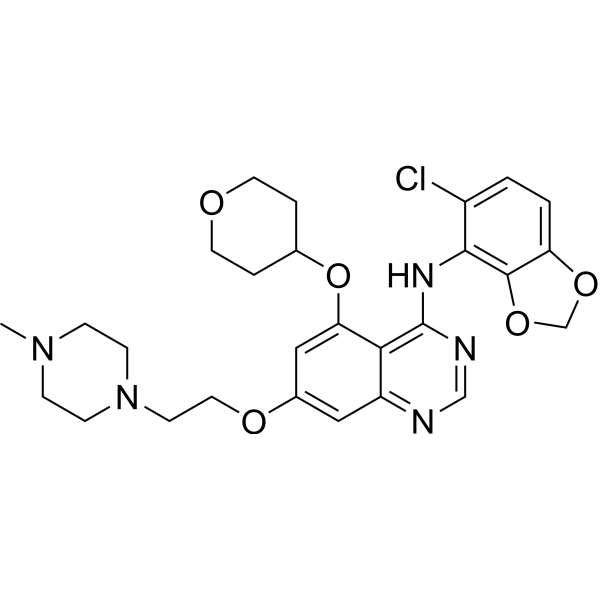| Description: |
Saracatinib (AZD0530) is a potent Src family inhibitor with IC50s of 2.7 to 11 nM for c-Src, Lck, c-YES, Lyn, Fyn, Fgr, and Blk and shows high selectivity over other tyrosine kinases. |
| Target: |
IC50: 2.7 nM (Src), 30 nM (v-Abl), 66 nM (EGFR), 200 nM (c-Kit)[1] |
| In Vivo: |
Saracatinib (AZD0530) treatment potently inhibits the proliferation of subcutaneously transplanted Src3T3 fibroblasts in mice and rats in a dose-dependent manner. In both models, significant inhibition of tumor growth is seen at doses ≥6 mg/kg/day (60% inhibition in mice and 98% inhibition in rats versus animals treated with vehicle) and, at the maximum doses investigated, complete tumor growth inhibition is observed (100% inhibition at 25 mg/kg/day in mice and 10 mg/kg/day in rats)[1]. |
| In Vitro: |
Saracatinib (AZD0530), an orally available Src inhibitor, demonstrates potent antimigratory and anti-invasive effects in vitro, and inhibits metastasis in a murine model of bladder cancer. Antiproliferative activity of Saracatinib varies between cell lines (IC50 0.2-10 μM). Saracatinib potently inhibits the proliferation of Src3T3 mouse fibroblasts and demonstrates variable antiproliferative activity in a range of human cancer cell lines containing endogenous Src. Sub micromolar growth inhibition of five of the human cancer cell lines tested with Saracatinib (tumor types: colon, prostate, lung, and leukemia) is observed with IC50 values of 0.2-0.7 μM. In 3-day MTS cell proliferation assays, Saracatinib inhibits proliferation of the Bcr-Abl-driven human leukemia cell line K562 with an IC50 of 0.22 μM. In the microdroplet migration assay, Saracatinib reduces the migration of human lung cancer A549 cells in a concentration-dependent manner (IC50 0.14 μM)[1]. |
| Kinase Assay: |
Investigation of the reversibility and the mechanism of Saracatinib inhibition is conducted using a full-length activated human Src in a continuous, coupled assay. ATP and peptide substrate (Src II peptide) concentrations are varied in turn (ATP 40-1280 μM; Src II peptide 100-800 μM), in conjunction with Saracatinib (0-30 nM), at saturating concentrations of the non-varied substrate (ATP 1.6 mM; Src II peptide 1.0 mM). The binding affinity of Saracatinib for inactivated Src (phosphorylated at tyrosine 527, not tyrosine 416) is measured using a BIAcore inhibition-in-solution assay. The assay followed competition binding between Saracatinib and an immobilized ureidoquinazoline for binding to Src. Data analysis is performed by unweighted nonlinear regression using GraFit, version 5 and an F-test is used to identify the most suitable equation[1]. |
| Cell Assay: |
Cell proliferation is assessed using a colorimetric 5-bromo-2′-deoxyuridine (BrdU) Cell Proliferation ELISA kit. Briefly, cells are plated onto 96-well plates (1.5×104 cells/well), the following day 0.039-20 μM Saracatinib in DMSO (at a final concentration of 0.5%) is added and the cells are incubated for 24 h. The cells are pulse labeled with BrdU for 2 h and fixed. Cellular DNA is then denatured with the provided solution and incubated with antiBrdU peroxidase for 90 min. Following three washes with phosphate-buffered saline, tetramethylbenzidine substrate solution is added and the plates are incubated on a plate shaker for 10-30 min until the positive control absorbance at 690 nm is approximately 1.5 absorbance units[1]. |
| Animal Administration: |
Mice and Rats[1] Female athymic mice (nu/nu) and rats (RH-rnu/rnu) are used. Animals are treated once daily by oral gavage with either vehicle alone or Saracatinib 6.25-50 mg/kg for 10-91 days. Tumor growth inhibition is calculated. For pharmacokinetic and pharmacodynamic analysis animals are humanely sacrificed and samples (plasma and tumor) are collected. Tumor samples are homogenized with 5 volumes of water and extracted with chloroform. Plasma and tumor samples are analyzed for Saracatinib concentration using high-performance liquid chromatography with tandem mass spectrometric detection after solid-phase extraction. |
| References: |
[1]. Green TP, et al. Preclinical anticancer activity of the potent, oral Src inhibitor AZD0530. Mol Oncol, 2009, 3(3), 248-261.
[2]. Fuse MA, et al. Combination Therapy With c-Met and Src Inhibitors Induces Caspase-Dependent Apoptosis of Merlin-Deficient Schwann Cells and Suppresses Growth of Schwannoma Cells. Mol Cancer Ther. Mol Cancer Ther. 2017 Nov;16(11):2387-2398. |






















